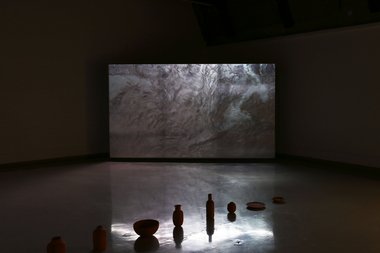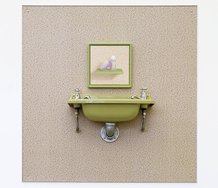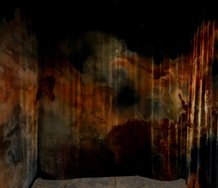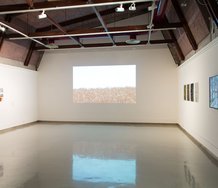Lucy Ovenden – 30 March, 2018
Daegan Wells' year as the Olivia Spencer Bower Awardee took him into his own archive and back into the archives of members of The Group, who he has investigated in his previous works. Wells traveled around New Zealand and came to the realisation that he did not feel he had the power to speak about the protest or the politics, but he does have the power to talk about how he feels. “How the lake meets the land and how you feel standing there”.
A beautiful part of visiting New Zealand art galleries is the likelihood that you will be able to experience an exhibition alone. Especially at nine o’clock on a misty Friday morning, on a university campus.
A Gathering Distrust began its life as an investigation into the effect the Save Manapouri Campaign had on protest culture in New Zealand. A pivotal point in our country’s modern political history and in the story of the artist himself, after he moved to Manapouri when his step-father took up a position with the hydroelectric project.
Daegan Wells‘ year as the Olivia Spencer Bower Awardee took him into his own archive and back into the archives of members of The Group, who he has investigated in his previous works. Wells traveled around New Zealand and came to the realisation that he did not feel he had the power to speak about the protest or the politics, but he does have the power to talk about how he feels. “How the lake meets the land and how you feel standing there”. Ideas of friendships both experienced and observed are continually coupled with those of history, homecomings, rights and reponsibilties.
A Gathering Distrust consists of three visual artworks and Mike Boulden‘s delicate sound work, at a volume just loud enough to accompany the viewer through the space.
I was drawn first to a film work shot at Lake Manapouri with a text overlay, telling the story of a fishing trip Wells had once taken with his father. The swell of the lake in the twilight reflects the pink sky one would expect to see while trout fishing at dusk or dawn. The text describes the items they filled their makeshift time capsule with: a bottle cap, fish hooks, and an only half memorable note. The artist’s interchanging use of ‘step-dad’ and ‘dad’ offers an insight into their own relationship.
A row of ceramic pots splits the gallery space in two. This assortment of rough, thick, orange pots, bowls and bottles are formed of clay collected from the edge of Lake Manapouri, ‘the lake of the sorrowing heart’. Wells spoke of his knowledge of the lake’s clay after having fallen into a seam of it as a child. A seam that he has brought to life in another form. Passing a nod to the potter Yvonne Rust, an extended source of inspiration for Wells, who wrote that a potter has no choice in their occupation because your clay finds you, even in the most isolated of places. This appears to ring true for Wells too, having taken up ceramics as a result of the luxury of having a studio which he believed needed to be filled with more than a computer, and his recent relocation back to Manapouri at the close of the Award year.
The third work, a loop of film showing the water’s movement, is projected onto a large screen and shines like phosphorescence on the polished floor. Watching this movement is like watching time pass, rhythmic and constant but inconsistent; faster and slower in different places. Searching through the dirty water perhaps for the seam of clay, perhaps for the time capsule. The water’s soft glow amid the dim gallery served to enhance the feeling of being invited into an open, personal and calm space, as one feels in the presence of a close friend.
The exhibition itself encouraged me to experience it slowly, the soft light welcoming me into the works and providing me with a comfortable sense of solitude.
Lucy Ovenden



 Advertising in this column
Advertising in this column Two Rooms presents a program of residencies and projects
Two Rooms presents a program of residencies and projects


This Discussion has 0 comments.
Comment
Participate
Register to Participate.
Sign in
Sign in to an existing account.